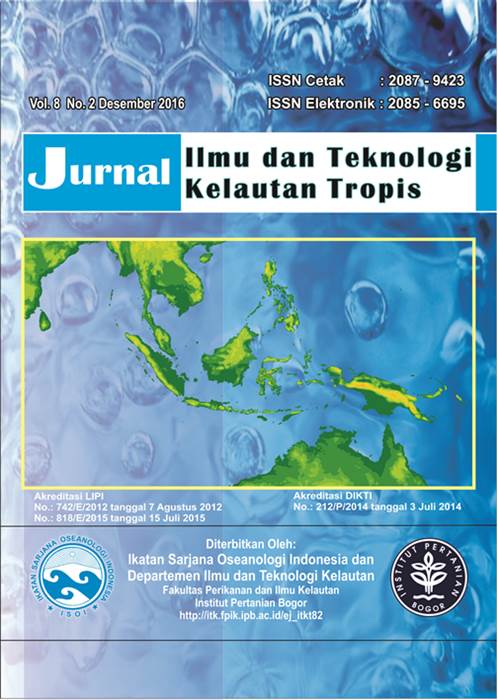APPLICATION OF ARTIFICIAL FEED WITH DIFFERENT PROTEIN CONTENT ON BLACKSADDLED CORAL GROUPER Plectropomus laevis NURSERY
Abstract
Blacksaddled coral grouper Plectropomus laevis is an export commodity and possess high economic value in Asian markets, but the wild population is already threatened. The purpose of this study was to determine the best food for improving growth and survival rate. The nursering were conducted using 9 fiberglass tanks with 1 m3 of volume for 6 month, with three treatment and 3 replicates. Three different foods were used as treatments, i.e.: Local commersial pellet with crude protein content 50% (A), im-port commersial pellet with cure protein content 55% (B) and trash fish (sardine) (C). The initial size of blacksaddled coral grouper seed were 2.5 cm total lengths (TL), 0.45 g body weight (BW). The stocking density of fry was reared at 250 fish per m3. A complete random design was used as an experiment design. Data was analysed using ANOVA statistics. Feeding times were twice a day at 08.00 and 15.00 local time; with dose at satiation. The samplings of fry were conducted every 15 day to measure of survival rate (SR), TL and BW. On the end of experiment was calculated economic ana-lized (BC ratio). The result showed that there was significant different (P<0.05) among treatments for SR and growth rate (GR). The better SR and GR was at treatment B with SR 96.5%, and GR 0.75g/day followed by treatment C (SR 90.5%: GR 0.54g/day) and treatment A (SR 81.5%: GR 0.42g/ day. The food conversion ratio was 1.15 in treatment A, 1.02 in B and 4.81 (wet weight) in C. From economic analized showed that the best BC ratio was in pellet 55% protein (B), followed by trash fish (C) and pellet 50% protein (A) with BC ratio of 1.75, 1.72 and 1.41 respectively.
Authors
This work is licensed under a Creative Commons Attribution 4.0 International License.
Jurnal Ilmu dan Teknologi Kelautan Tropis i is an open-access journal, meaning that all content is freely available without charge to the user or their institution. Users are allowed to read, download, copy, distribute, print, search, or link to the full texts of the articles in this journal without needing to request prior permission from the publisher or the author.
All articles published by Jurnal Ilmu dan Teknologi Kelautan Tropis are licensed under the Creative Commons Attribution 4.0 International License. This allows for unrestricted use, distribution, and reproduction in any medium, provided proper credit is given to the original authors.
Authors submitting manuscripts should understand and agree that the copyright of published manuscripts is retained by the authors. Copyright encompasses the exclusive rights of authors to reproduce, distribute, and sell any part of the journal articles in all forms and media. Reproduction of any part of this journal, its storage in databases, and its transmission by any form or media is allowed without written permission from Jurnal Ilmu dan Teknologi Kelautan Tropis.


